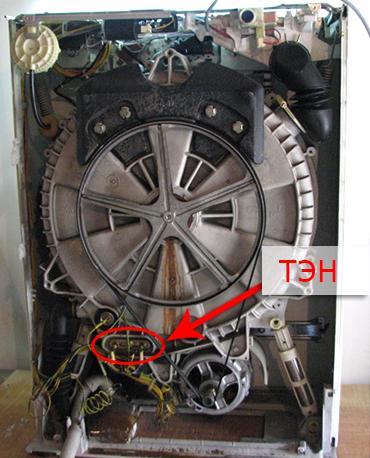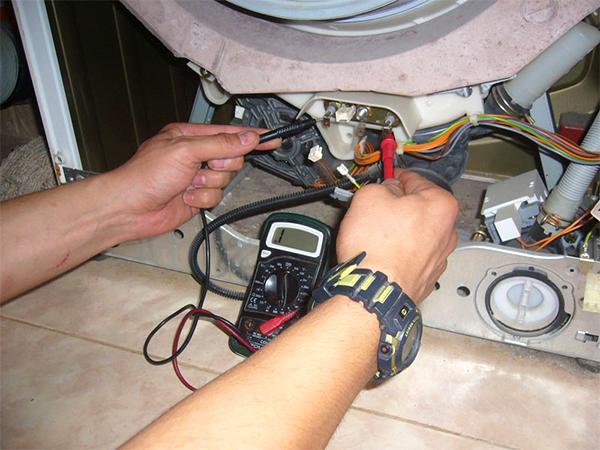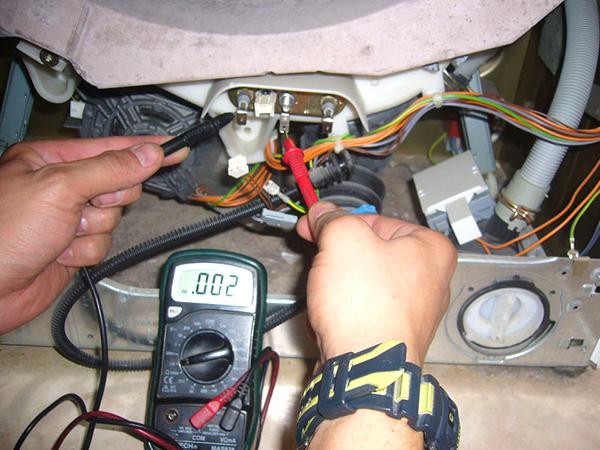One of the key parts in a washing machine is the TEN (Tubular Electric Heater). It is a metal tube, inside of which there is a spiral. This spiral under the influence of electric current heats up. Also, this spiral has a large resistance, which is why the electric current passing heats it. Between the spiral and the tube, the entire space is filled with a dielectric with high thermal conductivity.
As you already understood, the heating element constantly heats up and cools down, therefore the spiral in it wears out and loses its original properties, and at one moment it can completely burn out or short to the case. When will it happen washing machine stops heating water. If this happens, then you need to immediately check the heating element in the washing machine for operability. Luckily, this is very easy to do at home.
How to find a heating element in a washing machine
The heating element of different washing machines can be located both in front and behind. Define where is the heating element located in the washing machine can be done in one of the following ways:
- Inspect the washing machine from behind, if the back wall is large, then most likely the heating element is at the back.
- You can put the machine on its side and look from below where the heating element is located.
- Well, the most practical and probably 100% way is to remove the back cover of the washing machine, since it is removed very simply and see if the heating element is there. Even if it is not there, then it will not be too difficult to screw it on.

If you have decided on the location of the heating element in the washing machine, then it's time to ring it for integrity. Some professionals advise remove the heating element before calling, but we personally do not see the point in this. It seems to us that it is better to first ring the heater and make sure that it is not working, and only then remove it and change it to a new one.
Therefore, we will not remove it, but simply unscrew the wires from it. To do this, use a wrench or screwdriver and unscrew the nuts holding the wires.
We calculate the resistance of the heating element
To check the heating element for performance, you need to know how to call it and what data we should focus on. Therefore, before we start testing the water heater, we first need to calculate its normal resistance.
To calculate the resistance, we need the following data:
- U is the voltage applied to the heater. In our country, it is equal to the voltage of the household network, i.e. 220 V.
- P is the power of the heating element itself. To determine this parameter, look at the instructions from the washing machine and find the power of the device there. Or you can find your washing machine on the Internet by model and find out the power there.
Further according to the formula R=U²/P we get the resistance of the heater in its operating state in ohms. It is this figure that the multimeter should show us when the heating element rings. But first, let's look at an example of how to correctly calculate the resistance.
Let's say that we looked in the instructions for the washer that the power of the heating element is 2 Kw or 1800 watts.
We count according to the formula: R=220²/1800=26.8 ohm. That is, the resistance of our working heating element should be 26.8 ohms. Let's remember this figure and go to check the heater itself.
How to ring the heating element in the washing machine
Remove all wires suitable for the heating element. Thereafter set the multimeter to the resistance measurement mode in ohms at around 200 ohms and attach its ends to the heater terminals.

- The display of the multimeter should show a figure close to the calculated one, in our case it is about 26 ohms. In this case, the heater is correct.
- If the number 1 is displayed on the multimeter display, this means that there is a break inside the heater and it needs to be replaced.
- If you see a number close to 0 on the display, this means that there is a short circuit inside the heating element, and it is also faulty.
Let's say that your heating element showed the "correct" resistance, and, therefore, the spiral inside it is not broken. But the test of the tubular heater does not end there and you need to check something else, namely:
Checking the heating element for breakdown on the body
It is possible that the spiral itself is serviceable, but the dielectric is faulty, which is located in the space between it and the tube, and when electricity passes, the current can go to the body of the washing machine, which is very dangerous. Due to such a breakdown, there may even be sparks under the washing machine.
To check the heater for a breakdown on the body put the multimeter in dial mode, in this mode, if you close both wires of the device to each other, the multimeter will emit a squeak and the indicator will light up.
Then we touch the terminals of the heating element with one end of the multimeter, and with the other end of its case or the ground terminals.

If the multimeter squeaked, then your heating element is broken into the case and needs to be replaced.
In such a simple way, you can ring the water heater not only in the washing machine, but also in the kettle or any other appliance.

Comments
Regarding the continuity of the breakdown to ground, it is not true here. Punching may not necessarily be short and constant, the “tweeter” may not be found. But if you call by setting the handle of the multimeter to 2 megaohms, this will be true. The device should show infinity (one). If there is any value, it is a mass breakdown. And he will show himself when heated. And this applies not only to heating elements, but also to transformers, stator and rotor windings of electric motors, etc.
Tena resistance is 93 ohms, as I understand it, this is not normal; the machine does not heat water; the thermistor is normal. Ten wrong?